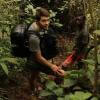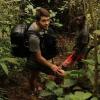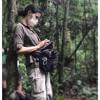Camera traps have been a key part of the conservation toolkit for decades. Remotely triggered video or still cameras allow researchers and managers to monitor cryptic species, survey populations, and support enforcement responses by documenting illegal activities. Increasingly, machine learning is being implemented to automate the processing of data generated by camera traps.
A recent study published showed that, despite being well-established and widely used tools in conservation, progress in the development of camera traps has plateaued since the emergence of the modern model in the mid-2000s, leaving users struggling with many of the same issues they faced a decade ago. That manufacturer ratings have not improved over time, despite technological advancements, demonstrates the need for a new generation of innovative conservation camera traps. Join this group and explore existing efforts, established needs, and what next-generation camera traps might look like - including the integration of AI for data processing through initiatives like Wildlife Insights and Wild Me.
Group Highlights:
Our past Tech Tutors seasons featured multiple episodes for experienced and new camera trappers. How Do I Repair My Camera Traps? featured WILDLABS members Laure Joanny, Alistair Stewart, and Rob Appleby and featured many troubleshooting and DIY resources for common issues.
For camera trap users looking to incorporate machine learning into the data analysis process, Sara Beery's How do I get started using machine learning for my camera traps? is an incredible resource discussing the user-friendly tool MegaDetector.
And for those who are new to camera trapping, Marcella Kelly's How do I choose the right camera trap(s) based on interests, goals, and species? will help you make important decisions based on factors like species, environment, power, durability, and more.
Finally, for an in-depth conversation on camera trap hardware and software, check out the Camera Traps Virtual Meetup featuring Sara Beery, Roland Kays, and Sam Seccombe.
And while you're here, be sure to stop by the camera trap community's collaborative troubleshooting data bank, where we're compiling common problems with the goal of creating a consistent place to exchange tips and tricks!
Header photo: Stephanie O'Donnell
No showcases have been added to this group yet.

- 1 Resources
- 5 Discussions
- 9 Groups
R&D lead @ enlaps


- 0 Resources
- 6 Discussions
- 2 Groups
- @AllySabur
- | Mr
"Founder of Worker Bees Africa, advancing bee conservation through innovation."
- 0 Resources
- 0 Discussions
- 3 Groups
- @Harsha
- | He/Him
I am a marine biologist / acoustic ecologist from Australia. Fascinated by bioacoustics, I always look forward to learning from people in conservation!
- 0 Resources
- 0 Discussions
- 11 Groups
Alberta Biodiversity Monitoring Institute (ABMI) & SENSR
We track changes in wildlife and their habitats in Alberta, working collaboratively to provide ongoing, relevant, scientifically credible information.


- 2 Resources
- 0 Discussions
- 4 Groups
- @Adwait
- | He
Postdoc at Max Planck Institute of Animal Behaviour
- 0 Resources
- 0 Discussions
- 4 Groups
Holder of BSc in Applied Zoology. Assistant Ecologist at Ruaha National park.


- 0 Resources
- 7 Discussions
- 12 Groups
University of Zurich
PhD student at the University of Zürich (CH) in PopEcol group, working with camera traps and mammals
- 0 Resources
- 0 Discussions
- 8 Groups
World Wide Fund for Nature/ World Wildlife Fund (WWF)
- 0 Resources
- 2 Discussions
- 5 Groups
- 0 Resources
- 0 Discussions
- 5 Groups
- @sroilo
- | she/her
- 0 Resources
- 0 Discussions
- 4 Groups
- @nabilla.nuril
- | She/Her
University College London (UCL)
- 0 Resources
- 0 Discussions
- 11 Groups
Since 2016, ZSL’s Instant Detect team have been working on improving metal detecting sensors for anti-poaching. The team believe that using metal detecting sensors will provide a highly targeted detection of potential...
10 August 2020
In this case study from herpetologist Emily Taylor, we learn about the best methods and gear used to track snakes, lizards, and other reptiles and amphibians via radio-telemetry, and how these techniques have changed...
31 July 2020
This exciting news article about The Global Wetland Project's FishID platform discusses the latest improvements and developments in using deep learning to identify individual fish species underwater. In addition to...
28 July 2020
Article
In this article from BearID Project, Director and Software Developer Ed Miller walks us through using their application to identify individual bears from photographs. Ed shows us how to easily use BearID remotely in the...
21 July 2020
In this three-part WILDLABS feature article series, we take a look at the various technologies used to fight the greatest threat to wild condors, lead poisoning, explore the innovations changing the ways we study and...
2 July 2020
In this three-part WILDLABS feature article, we're taking a look at the various technologies used to fight the greatest threat to wild condors, lead poisoning, explore the innovations that may change the way we study...
25 June 2020
Creating bold conservation tech solutions requires each of us to find the intersection between our skills and passions. In this case study on the new Aqualink reef monitoring system, a unique citizen science project...
9 June 2020
Our friends at the Conservation Leadership Programme are pleased to announce the winners of their 2020 CLP Team Award! Today, they'd like to feature some of the inspiring teams and projects that have earned this honor,...
8 June 2020
Conservation technology largely consists of two categories: tools to monitor and study wildlife and their habitats, and solutions to mitigate or prevent negative human impacts. The fight against poaching in particular...
4 June 2020
Funding
The 2020 Hackaday Prize competition has begun! This year, Conservation X Labs has partnered with the Hackaday Prizes as one of four nonprofits seeking tech-based solutions to urgent challenges. Conservation X Labs'...
26 May 2020
In this three-part WILDLABS feature article, we'll take a look at the various technologies used to fight the greatest threat to endangered condors, explore the innovations that may change the way we study and understand...
5 May 2020
Funding
Want to compete in the iWildCam 2020 competition identifying species in camera trap images to support biodiversity monitoring efforts and automatic species classification model improvements? Because the Workshop on Fine...
4 May 2020
August 2025
event
event
September 2025
event
event
event
April 2023
February 2023
58 Products
Recently updated products
4 Products
Recently updated products
| Description | Activity | Replies | Groups | Updated |
|---|---|---|---|---|
| Ok, understand. Note, the bluetooth feature is very short range, just to configure the camera from your phone when standing nearby. Wifi will give you some longer range and... |
|
Camera Traps | 3 years 6 months ago | |
| Vasudev I have had no issues using ubiquiti device and pushing internet out to 5 miles line of site, what I am curious what are you using for you camera on the other end, I... |
+11
|
Camera Traps | 3 years 8 months ago | |
| Antoineede they are a mesh style of camera, one links to the other and then send pictures back to the home unit where you either send them via cellular or you check the sd card.... |
|
Camera Traps | 3 years 8 months ago | |
| Hi Morgan! We're currently still working out the exact terms. Are there any specific concerns that you had? |
|
Camera Traps | 3 years 8 months ago | |
| Hey Ellie-- Glad to see you getting started with this. I'll speak to the data-storage question, it might be worth it for you to do something like paying for extra... |
|
Camera Traps | 3 years 10 months ago | |
| Thank Capreolus, for your feedback, did you try it where the cellular network is weak? Thank you. |
+4
|
Camera Traps | 3 years 11 months ago | |
| Camera traps are widely used for studying terrestrial animal populations. One method for estimating animal abundance from data collected by... |
|
Camera Traps | 4 years ago | |
| Hi everyone, We're half an hour away from our special Ethics panel episode today at 11 AM ET / 4 PM BST, where... |
|
Ethics of Conservation Tech, Camera Traps | 4 years ago | |
| @Freaklabs Akiba may be interested? |
+7
|
Camera Traps | 4 years ago | |
| My guess is that the camera triggering will prove to be far less of a challenge than getting ethical approval for penning livestock where predators can reach them. If you have... |
|
Camera Traps | 4 years ago | |
| Hi everyone, We're excited to welcome Nicole Flores to Tech Tutors to walk us through getting started with Wildlife Insights! ... |
|
AI for Conservation, Camera Traps, Data management and processing tools | 4 years ago | |
| Do you need the photos during the timelapse, or just all at once at the end? If the latter, how many exposures will you need per timelapse recording? Depending on your... |
+6
|
Camera Traps | 4 years ago |












































